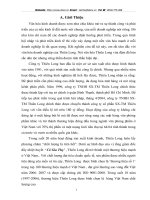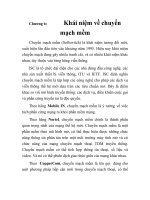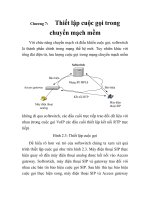TỔNG QUAN THUỐC VẬN MẠCH
Bạn đang xem bản rút gọn của tài liệu. Xem và tải ngay bản đầy đủ của tài liệu tại đây (889.67 KB, 19 trang )
<span class='text_page_counter'>(1)</span><div class='page_container' data-page=1>
VASOPRESSOR REVIEW
Presented by: Christopher Allison, MD
Resident Physician
</div>
<span class='text_page_counter'>(2)</span><div class='page_container' data-page=2>
OUTLINE
•
Why is my patient in shock?
•
How do I know when I have given enough fluids?
•
What medications can I use to raise blood pressure?
•
What is my goal when starting a pressor?
</div>
<span class='text_page_counter'>(3)</span><div class='page_container' data-page=3>
SHOCK IS THE INADEQUATE DELIVERY (AND
UTILIZATION) OF OXYGEN AND NUTRIENTS TO TISSUES
Not all hypotensive patients are in shock.
</div>
<span class='text_page_counter'>(4)</span><div class='page_container' data-page=4>
MARKERS OF SHOCK
Reduced urine output
Altered mental status
Elevated lactate
Elevated liver enzymes
Low blood pressure
Delayed capillary refill
</div>
<span class='text_page_counter'>(5)</span><div class='page_container' data-page=5>
WHY IS MY PATIENT IN SHOCK?
Hypovolemic
Distributive
(reduced vascular tone)Obstructive
Cardiogenic
Hemorrhage
Inadequate intake
Diarrhea/vomiting
Fistula output
Sepsis
Anaphylaxis
Neurogenic
Myocardial infarction
Acidosis / Electrolytes
Toxins
</div>
<span class='text_page_counter'>(6)</span><div class='page_container' data-page=6>
THE “BIG TOE” TEST
Lars Plougmann
F
a
st
Refill
Distributive shock
Sl
ow
Refi
ll
Not distributive shock
</div>
<span class='text_page_counter'>(7)</span><div class='page_container' data-page=7>
BEDSIDE ULTRASOUND
THE “RUSH” EXAM
Weingart et al, Emcrit.org
Right ventricle
Left ventricle
Ultrasoundoftheweek.com
sonomojo.org <sub>Ultrasound-cases.blogspot.com</sub>
Critical Care Research and Practice
</div>
<span class='text_page_counter'>(8)</span><div class='page_container' data-page=8>
DOES MY PATIENT NEED
MORE FLUID?
Too little fluid:
Too much fluid:
Crit Care Med. 2011;39:259–265
</div>
<span class='text_page_counter'>(9)</span><div class='page_container' data-page=9>
VOLUME RESPONSIVENESS
</div>
<span class='text_page_counter'>(10)</span><div class='page_container' data-page=10>
ASSESSING VOLUME
RESPONSIVENESS
Do not use central
venous pressure!
Monnet et al, Ann Intensive Care. 2016; 6: 111.
Passive Leg Raise
A temporary 300-500ml fluid bolus.
Maximum effect in about 1 minute.
Other strategies exist:
Stroke volume variation
End expiratory occlusion
Mini fluid challenge
When studied, volume responsiveness is
measured by change in <i>cardiac </i>
<i>output,</i> not blood pressure.
</div>
<span class='text_page_counter'>(11)</span><div class='page_container' data-page=11>
PRESSOR PHYSIOLOGY:
THE RECEPTORS
⍺
1
β1
β2
Dopamine
receptor
vasoconstriction Inotropy
(stronger heart
contractions)
Chronotropy
(faster heart
rate)
Inotropy
Bronchodilation
Sodium
excretion
Gut vasodilation
</div>
<span class='text_page_counter'>(12)</span><div class='page_container' data-page=12>
PRESSORS:
ADRENERGIC AGENTS
⍺
1
β1
β2
Dopamine
receptors
epinephrine
norepinephrine
phenylephrine
dopamine
dobutamine
isopreterenol
++
++++
+++
++++
++
+
++++
high doses medium doses low doses
+
++++
++
++++
+++
</div>
<span class='text_page_counter'>(13)</span><div class='page_container' data-page=13>
PRESSOR PHYSIOLOGY:
OTHER TARGETS
Vasopressin
receptors
Troponin C,
ATP-dependent
K+ channels
cAMP
phosphodiesterase-3
(PDE-3)
vasoconstriction
Anti-diuresis
Calcium sensitization
Inotropy and
vasodilation
Inhibition leads to
increased inotropy
and vasodilation
Senz and Nunnink. Emerg Med Australas. 2009 Oct;21(5):342-51.
<i>Levosimenden</i> <i>Milrinone</i>
</div>
<span class='text_page_counter'>(14)</span><div class='page_container' data-page=14>
SEPTIC SHOCK
Primary Problems:
Decreased systemic
vascular resistance (SVR) Depressed myocardial function
Preferred Pressors:
Norepinephrine Vasopressin Dopamine
Norepinephrine in meta-analysis of randomized controlled trials has slightly improved
mortality, fewer arrhythmias vs. dopamine. J Intensive Care Med. 2012 May-Jun;27(3):172-8
No difference in outcomes between first-line use of vasopressin vs. norephrine in
septic shock. NEJM 2012 May-Jun;27(3):172-8
</div>
<span class='text_page_counter'>(15)</span><div class='page_container' data-page=15>
CARDIOGENIC SHOCK
Primary Problems:
Depressed myocardial
function Usually systemic vascular resistance (SVR) is increased
Preferred Pressors:
Dobutamine
Milrinone
Depends on the specific scenario. Cardiac output response to
treatment must be followed closely. No evidence for best first choice.
Dopamine Norepinephrine
High SVR, hypertension Low SVR, hypotension
Will often lower blood pressure.
</div>
<span class='text_page_counter'>(16)</span><div class='page_container' data-page=16>
OBSTRUCTIVE SHOCK
(PULMONARY EMBOLISM)
Primary Problems:
Myocardial contractility
inadequate to overcome
obstruction
Preferred Pressors:
Norepinephrine or epinephrine
Increase MAP to maintain right ventricle perfusion; increase inotropy.
Animal and small human studies show improved RV oxygen delivery with
norepinephrine.
At Maine Medical Center, we usually use norepinephrine first; though some use epinephrine.
You fix the tension pneumothorax and the tamponade with a procedure, not pressors.
Right ventricular RV failure
Hypotension
</div>
<span class='text_page_counter'>(17)</span><div class='page_container' data-page=17>
NEUROGENIC SHOCK
(SPINAL CORD INJURY)
Primary Problems:
Disrupted sympathetic nervous system signaling leads to decreased systemic
vascular resistance (SVR).
A higher spinal cord lesion will sometimes cause bradycardia
Preferred Pressors:
Phenylephrine if not bradycardic. J Spinal Cord Med. 2008; 31(4): 403–479.
Norepinephrine is a reasonable first line choice, especially if bradycardic.
</div>
<span class='text_page_counter'>(18)</span><div class='page_container' data-page=18>
DOES MY PATIENT NEED A
CENTRAL VENOUS CATHETER?
Systematic review of mostly case series with 204
extravasation events:
85.3% of adverse events were in
IVs distal to
antecubital or popliteal fossae
.
96.8% of adverse events occurred
after 4 hours
J Intensive Care Med. 2017 Jan 1:885066616686035
A retrospective study at one institution
<i>with a protocol</i>
for
peripheral IV infused pressors showed:
4% rate of extravasation (8 of 485 subjects)
Median time to extravasation = 21 hours
No serious injuries
requiring surgery or antidote
J Crit Care 2015; 30 (3): 653.e9 – 653.e17.
<b>Conclusion:</b>
We believe pressors given through
a peripheral IV are safe if:
- Given through a secure IV,
preferably at or proximal to the
antecubital fossae
- The IV site is monitored
frequently
</div>
<span class='text_page_counter'>(19)</span><div class='page_container' data-page=19></div>
<!--links-->









